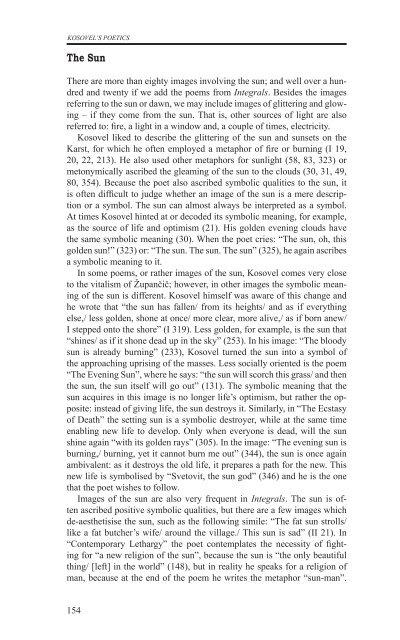razprave (pdf) - Društvo za primerjalno književnost - ZRC SAZU
razprave (pdf) - Društvo za primerjalno književnost - ZRC SAZU
razprave (pdf) - Društvo za primerjalno književnost - ZRC SAZU
- No tags were found...
You also want an ePaper? Increase the reach of your titles
YUMPU automatically turns print PDFs into web optimized ePapers that Google loves.
KOSOVEL’s poeticsThe SunThere are more than eighty images involving the sun; and well over a hundredand twenty if we add the poems from Integrals. Besides the imagesreferring to the sun or dawn, we may include images of glittering and glowing– if they come from the sun. That is, other sources of light are alsoreferred to: fire, a light in a window and, a couple of times, electricity.Kosovel liked to describe the glittering of the sun and sunsets on theKarst, for which he often employed a metaphor of fire or burning (I 19,20, 22, 213). He also used other metaphors for sunlight (58, 83, 323) ormetonymically ascribed the gleaming of the sun to the clouds (30, 31, 49,80, 354). Because the poet also ascribed symbolic qualities to the sun, itis often difficult to judge whether an image of the sun is a mere descriptionor a symbol. The sun can almost always be interpreted as a symbol.At times Kosovel hinted at or decoded its symbolic meaning, for example,as the source of life and optimism (21). His golden evening clouds havethe same symbolic meaning (30). When the poet cries: “The sun, oh, thisgolden sun!” (323) or: “The sun. The sun. The sun” (325), he again ascribesa symbolic meaning to it.In some poems, or rather images of the sun, Kosovel comes very closeto the vitalism of Župančič; however, in other images the symbolic meaningof the sun is different. Kosovel himself was aware of this change andhe wrote that “the sun has fallen/ from its heights/ and as if everythingelse,/ less golden, shone at once/ more clear, more alive,/ as if born anew/I stepped onto the shore” (I 319). Less golden, for example, is the sun that“shines/ as if it shone dead up in the sky” (253). In his image: “The bloodysun is already burning” (233), Kosovel turned the sun into a symbol ofthe approaching uprising of the masses. Less socially oriented is the poem“The Evening Sun”, where he says: “the sun will scorch this grass/ and thenthe sun, the sun itself will go out” (131). The symbolic meaning that thesun acquires in this image is no longer life’s optimism, but rather the opposite:instead of giving life, the sun destroys it. Similarly, in “The Ecstasyof Death” the setting sun is a symbolic destroyer, while at the same timeenabling new life to develop. Only when everyone is dead, will the sunshine again “with its golden rays” (305). In the image: “The evening sun isburning,/ burning, yet it cannot burn me out” (344), the sun is once againambivalent: as it destroys the old life, it prepares a path for the new. Thisnew life is symbolised by “Svetovit, the sun god” (346) and he is the onethat the poet wishes to follow.Images of the sun are also very frequent in Integrals. The sun is oftenascribed positive symbolic qualities, but there are a few images whichde-aesthetisise the sun, such as the following simile: “The fat sun strolls/like a fat butcher’s wife/ around the village./ This sun is sad” (II 21). In“Contemporary Lethargy” the poet contemplates the necessity of fightingfor “a new religion of the sun”, because the sun is “the only beautifulthing/ [left] in the world” (148), but in reality he speaks for a religion ofman, because at the end of the poem he writes the metaphor “sun-man”.154
















